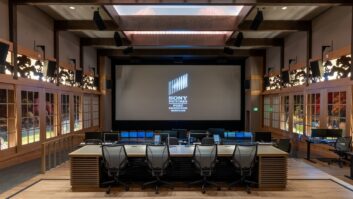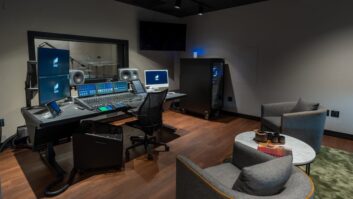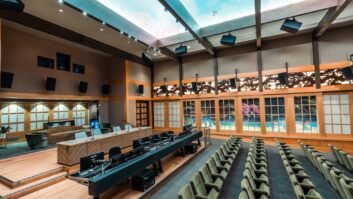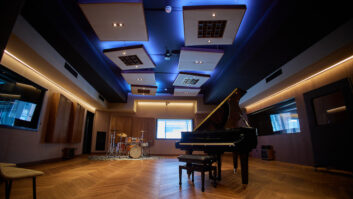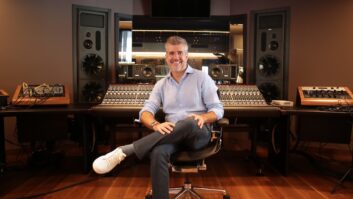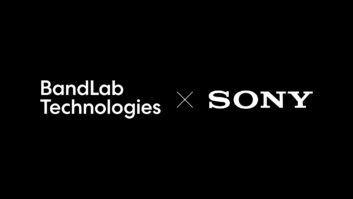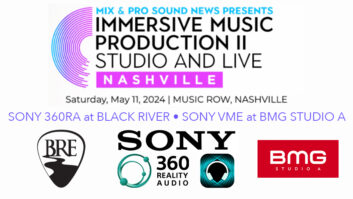There’s something very different about this one. A first glance at the classic lines of the Sony DRE-S777’s cherry wood veneer front panel — which looks like the dashboard of an old Jaguar (great choice, by the way) — tells you that you’re in for a special ride.
Though the DRE-S777 is a digital reverb, the feature that makes it stand out is that it uses real sampled halls and spaces, as opposed to digitally simulated environments. It also offers a sampling option so that users can capture favorite acoustic spaces of their own. A newly developed DSP allows Real Impulse Response (RIR) processing, providing high-speed calculations that re-create natural reverberation based on actual acoustic spaces.
The DRE-S777 is a software-dependent unit. Using the front panel CD-ROM drive, users can load a variety of existing acoustic spaces, and user-sampled environments can be loaded from Memory Stick removable media via a front panel card slot. Included with the unit is a CD-ROM with some very good sampled spaces to work with: two halls, two churches, a studio and two plate reverbs.
For more variety, an optional series of sampled halls and spaces from around the world is available. The DASK-S700 Complete World Sample CD-ROM Library ($930) includes three sampled reverb software packages: European Acoustic Spaces (DASK-S701), American Acoustic Spaces (DASK-S702) and Japanese Acoustic Spaces (DASK-S703). The library offers reverb sample algorithms for a diverse collection of pre-recorded spaces, including well-known recording studios (e.g., New York City’s Avatar and Ocean Way in L.A.), concert halls and cathedrals from around the world, some interesting utility spaces (try the Goto Planetarium or Tokyo’s Tamanoyu Bathhouse for some “different” sounds) and natural environments, such as Japan’s Kamaishi iron mine and even the Grand Canyon — the latter captured with the help of Paul Winter.
THE HARDWARE
The DRE-S777 is now offered in two versions to suit various user needs. The $9,000 DRE-S777/2 is a digital-only I/O model (2 channels in/4 channels out, both in AES/EBU track-pair format on XLRs), and is intended for applications where analog interfacing is not required, such as studios with digital consoles. The $11,500 DRE-S777/PAC features analog I/Os (2 in/4 out) with high-quality 24-bit A/D and D/A conversion, and is ideal for traveling engineers who work on a variety of consoles. The DRE-S777/PAC should also appeal to rental companies, studios with analog boards, and hybrid facilities with both analog and digital mixers that need to move the DRE-S777 between rooms. The DASK-S704 sampling hardware/software option that allows users to sample their own spaces is $930.
Both the DRE-S777/2 and DRE-S777/PAC models now include the (previously optional) DABK-S703 DSP expansion card, which allows the normally mono-in/stereo-out unit to operate in different modes: stereo in/stereo out; mono in/4-channel out; mono in/stereo out (at 88.2 or 96 kHz); and split in/4-channel out (two sets of mono inputs are output as two sets of stereo outputs). My personal favorite is the split-mode feature whereby two mono inputs drive two sets of stereo outputs (the popular Lexicon 480 configuration), which allows you to run two different reverbs. You get twice the reverb for the buck.
Other features include 24-bit resolution, 4-band EQ, 92 user preset memories, self-diagnostics, MIDI control, Memory Stick storage and silent (fan-free!) operation. On the rear panel are the digital and/or analog inputs/outputs, word sync in/out on BNC connectors, MIDI In and Out/Thru jacks, AC cord socket, a chassis ground lug and an RS-232 port for maintenance/servicing.
IN SESSION
Loading up the DRE-S777 software from CD-ROM reminds me a lot of a Sony PlayStation. However, the unit does take a while to load: three minutes to be exact! If you’re unsure which parameter to hit and accidentally press Load, then you’ll have three minutes of waiting while you hold that thought and retain the creativity of the moment. This is the DRE-S777’s major downside, but — like a PlayStation — once you’re used to the parameters and can navigate around, you are definitely in for an ear candy treat.
The two-rackspace front panel is simply laid out, with one knob for entering parameter data values or selecting presets, four soft keys and a large display window. The window display is easy to use and extremely intuitive. You don’t even need a manual to use it. (Not a suggestion, just an example of the unit’s user-friendliness.)
The DRE-S777 is well-thought out, and it doesn’t have a thousand parameters or bells and whistles (like some other digital units), but it has just enough truly useful parameters, like input trim, reverb decay time (variable from 0.3 to 5.5 seconds), up to 500 ms of predelay, peak hold meter settings, wet/dry levels, bypass, mutes and 4-band equalization (with fully parametric mid bands) available for each sampled venue. One reason for the DRE-S777’s limited parameter control for adjusting reverbs is that it’s based on actual sampled environments, which can be made smaller — useful for keeping large spaces under control — but can’t be made larger. Along with various cute icon images of stages, halls, churches, spaces, etc., the display shows a diagram of the mic and speaker (sound source) placement for each sampled reverb. Users are given the ability to change and adjust these different speaker/microphone placement perspectives: very clever, very useful.
SAMPLING!
Other than the fact that it sounds great, the DRE-S777’s self-sampling feature — its ability to actually sample your own favorite spaces — really sets this box apart from any other unit I’ve used. The sampling option includes a 64MB Memory Stick, which is used to store reverbs sampled by the user. In addition, this Memory Stick (which is encrypted with a special key) also allows nine “cached” presets to be stored permanently on the stick for quick access. It’s actually possible to store from 10 to 15 samples on a Memory Stick, depending on the file size of the parameters used when sampling the room.
One of the DRE-S777’s odd redundancies is that it requires Memory Sticks for user storage, yet the front panel has a PC card slot, so the Memory Stick must be placed in a PC card adapter (included with the unit), which slides into the slot. Buy lots of sticks and have fun experimenting.
In concept, the sampling process is easy but requires a fair amount of time, some loud SPLs and more time (and patience) to experiment. I tried to sample the Hammerstein Ballroom in New York City, but between the room’s heavy booking schedule and my availability, I didn’t have enough time to get exactly what I wanted. Hammerstein would be a good arena to add to the collection of other halls available for the DRE-S777, and once I finish some of my current West Coast projects, I plan to spend a little more time and get it right. However, I do have something sampled on my disk, and even though it wasn’t what I would consider the sweet part of Hammerstein, it’s, nonetheless, still a useful space and I now have a sampled space that no one else has.
TAIL OUT
There are plenty of useful spaces in the CD-ROM library (see sidebar for complete list), but I fell in love with the Giandomenico Studio. Originally a movie house in the 1920s and 1930s, it was later turned into a photographic studio but was a popular site for recording classical music, with a full, fairly bright ambience. I understand the building has since been torn down, but its ambience is now preserved forever on disk in the DRE-S777.
Will the DRE-S777 change your life? Probably not, but it does make you want to go and find more things to use reverb on. With this machine, the old days of smooth, round, warm reverb have returned. Did I mention that it sounds great? Well, it sounds awesome. It is amazingly quiet — no complaints here. The sound of the halls and churches is supreme. To an old-skool fool like myself, if I hadn’t seen it with my own eyes, you couldn’t have convinced me with my own ears. The algorithms are so smooth. The sound is warm — yet clean — without any of that digital brittleness usually associated with digital reverbs.
Now that I’ve used this box for a while, I don’t think Sony will ever be able to get it back from me. This one’s a keeper!
Sony Professional Audio, 1 Sony Drive, Park Ridge, NJ 07656; 201/930-1000; fax 201/358-4907; www.sony.com/proaudio.
Jimmy Douglass is a New York-based producer/engineer whose recent projects include Ginuwine and Missy Elliott in 5.1.
Spaces: The Final Frontier
A Sony engineering team traveled the globe to sample actual acoustic signatures from legendary venues. Using a unique “convolution” technique that converts a sweep tone generated at a sampling site into millions of frequency-dependent pulse tones, the team collected a well-defined acoustical footprint for each sampled space, and they are now stored on various CD-ROMs. Priced at $930 (or $500/CD separately), the DASK-S700 Complete World Sample CD-ROM Library features three sampling reverb software collections:
DASK-S701: European Acoustic Spaces
- Concertgebouw, Amsterdam
- Grosser Musikvereinssaal, Vienna
- Konzerthaus, Berlin
- Westerkerk, Amsterdam
- Jesus-Christus-Kirche, Berlin
- St. Vincent de Cardona, Cardona
DASK-S702: American Acoustic Spaces
- Avatar Studio A, New York City
- Ocean Way Studio B, Los Angeles
- Enterprise E2, Los Angeles
- Giandomenico Studios, New Jersey
- St. John the Divine Church, New York City
- Grand Canyon, Arizona
DASK-S703 Japanese Acoustic Spaces
- Sedic Audio Studio, Tokyo
- Yokohama Nohgaku-dou Noh Hall, Kanagawa
- Tamanoyu Bathhouse, Tokyo
- Ohya Shiryoukan Stone Quarry, Tochigi
- Kamaishi Iron Mine, Iwate
- Goto Planetarium Dome, Tokyo
- Hotaka Mountain Range, Nagano
Spec Sheet: Sony DRE-S777/PAC
DSP
Reverb Algorithm: Real Impulse Response
Reverb Time: 0.3 to 5.5 seconds
Reverb Predelay: 0 to 500 ms
EQ Type: 4-band, ±12 dB
HF Shelving, 2 to 19 kHz
MHF Parametric, 640 to 12.4k Hz (Q=0.1-4)
MLF Parametric, 52.6 to 1k Hz (Q=0.1-4)
LF Shelving, 5.1 to 420 Hz
DABK-S701 A/D Converter
Input Impedance: 10k or 600 ohms
Dynamic Range: 110 dB
Signal/Noise Ratio: 110 dB
THD: 0.005% (-20 dBFS)
Nominal/Max Input: +4/+24 dBu
Crosstalk (@ 8 kHz): 90 dB
Bandwidth (44.1/48 kHz): 20 to 20k Hz (+0.2/-0.3 dB)
Bandwidth (88.2/96 kHz): 20 to 40k Hz (+0.2/-0.3 dB)
DABK-S702 D/A Converter
Output Impedance: under 50 ohms
Dynamic Range: 110 dB
Signal/Noise Ratio: 110 dB
THD: 0.015% (-20 dBFS)
Nominal/Max Output: +4/+24 dBu
Crosstalk (@ 8 kHz): 90 dB
Bandwidth (44.1/48 kHz): 20 to 20k Hz (+0.2/-0.3 dB)
Bandwidth (88.2/96 kHz): 20 to 40k Hz (+0.5/-0.6 dB)
Dimensions
Size (in inches): 19×3.5×20.4 (W×H×D)
Weight: 33 lbs., loaded

